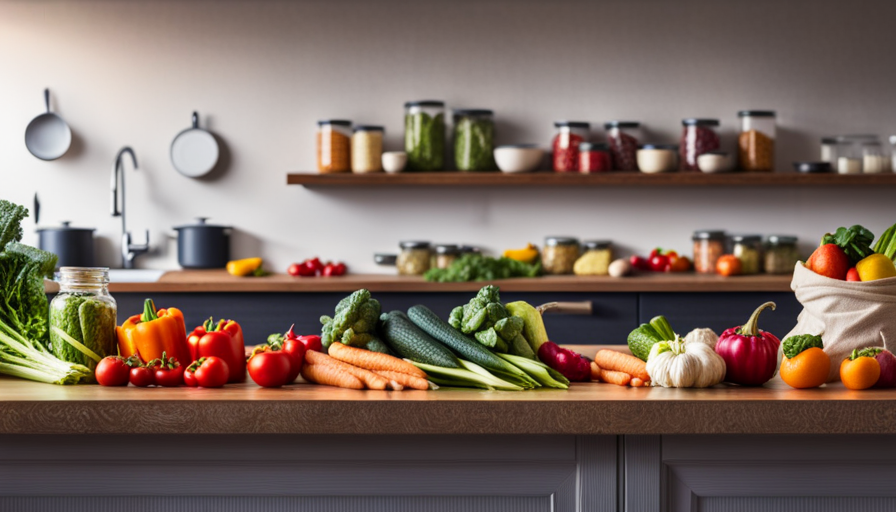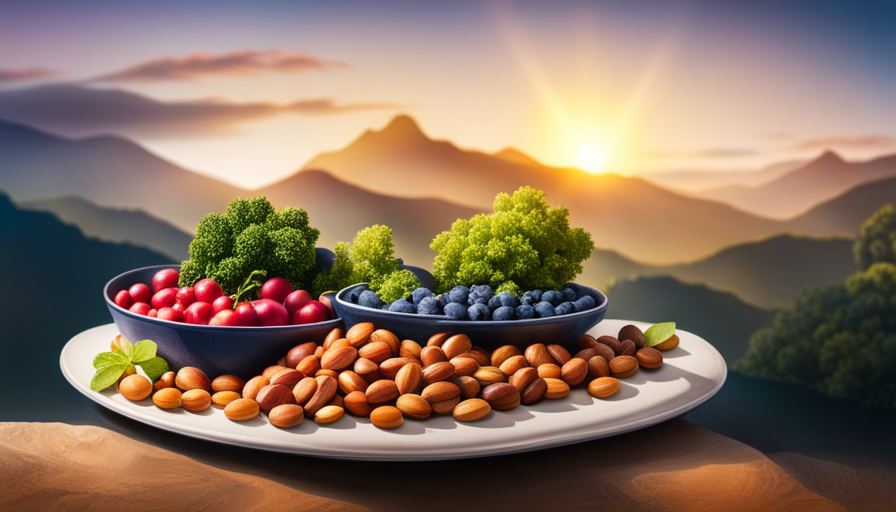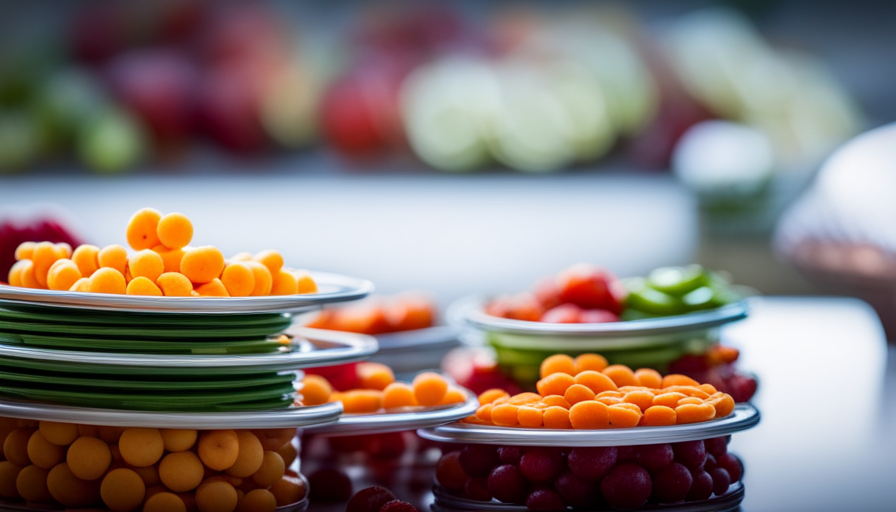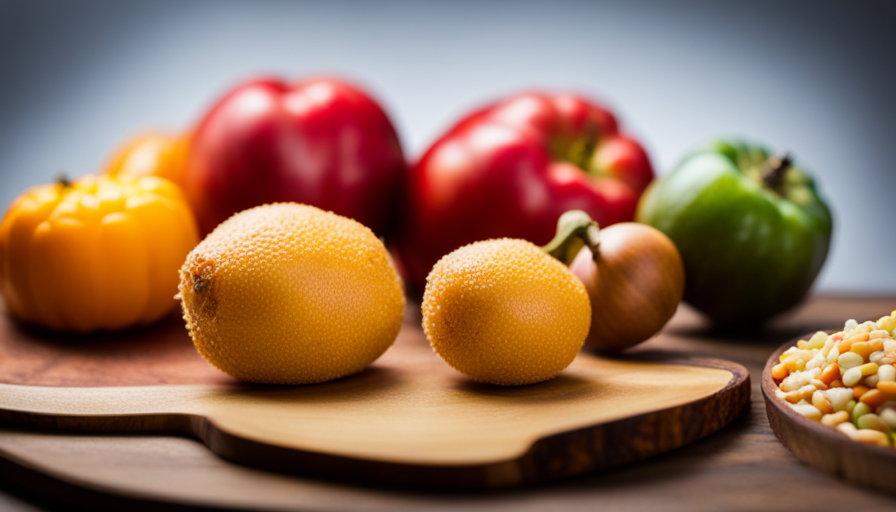Were you aware that storing fruits and vegetables improperly can result in a notable loss of nutrients? Studies indicate that the nutritional content of produce can decrease by as much as 50% within a short span of time due to improper storage.
As a nutritionist, I understand the importance of maintaining the freshness and nutritional content of raw food. That’s why I want to share with you the best practices for storing vegetables and fruits, so you can enjoy their full benefits.
From leafy greens and herbs to avocados and berries, each type of produce requires specific storage methods to preserve their texture, flavor, and nutrients. In this article, I will provide evidence-based recommendations on how to properly store different types of vegetables and fruits, including temperature recommendations, packaging techniques, and the ideal duration for storage.
Get ready to maximize the freshness and nutritional value of your raw food with these practical tips and advice.
Key Takeaways
- Improper storage of fruits and vegetables can lead to significant nutrient loss.
- Most fruits and vegetables should be stored in the refrigerator to slow down ripening and extend shelf life.
- Storing different types of produce separately prevents cross-contamination and preserves individual flavors.
- Proper storage techniques and containers help maximize the nutritional benefits of raw food and prevent cross-contamination.
The Importance of Proper Storage for Raw Food
You need to make sure you store your raw food properly if you want to keep it fresh and full of nutrients. Proper storage techniques are essential for preventing food waste and ensuring the longevity of your fruits and vegetables.
When it comes to storing raw food, there are a few key factors to consider. Firstly, it’s important to keep your produce in specific storage containers that are designed to maintain freshness. For example, airtight containers or plastic bags can help prevent moisture loss and keep your fruits and vegetables crisp. Additionally, storing different types of produce separately can help prevent cross-contamination and preserve their individual flavors.
Temperature also plays a crucial role in maintaining the nutritional value of raw food. Most fruits and vegetables should be stored in the refrigerator, as it helps slow down the natural ripening process and extends their shelf life. However, some items, like tomatoes and bananas, are best stored at room temperature to maintain their flavor and texture.
Understanding the shelf life of different fruits and vegetables is essential for proper storage. Some produce, like leafy greens and berries, have a shorter shelf life and should be consumed within a few days. On the other hand, items like carrots and apples can last for weeks when stored correctly.
In the next section, we’ll delve into the concept of shelf life and explore the optimal storage durations for various fruits and vegetables.
Understanding the Shelf Life of Different Fruits and Vegetables
Discover the surprising lifespan of various fruits and vegetables, leaving you with a bittersweet taste of their fleeting beauty. Understanding optimal storage conditions is key to preventing spoilage and preserving the nutritional content of your produce. By maximizing freshness and prolonging shelf life, you can reduce food costs and minimize waste. To help you achieve this, I have created a table that outlines the recommended storage methods for common fruits and vegetables.
| Fruits | Vegetables |
|---|---|
| Strawberries | Carrots |
| Apples | Broccoli |
| Bananas | Bell peppers |
| Oranges | Cucumbers |
| Grapes | Tomatoes |
When storing fruits and vegetables, it is important to consider factors such as temperature, humidity, and air exposure. For example, strawberries should be stored in a refrigerator at a temperature of 32-36°F with high humidity to prevent bacterial growth and minimize oxidation. Carrots, on the other hand, can be stored in a cool, dark place at a temperature of 32-40°F to maintain their flavor and texture.
By understanding these optimal storage conditions, you can ensure that your fruits and vegetables stay fresh for longer periods, allowing you to enjoy their full nutritional benefits. Now, let’s delve into the next section on storing leafy greens and herbs.
Storing Leafy Greens and Herbs
When it comes to leafy greens and herbs, storing them properly is essential to maintain their freshness and flavor. Storing delicate greens can be a challenge, as they’re prone to wilting and discoloration. To prevent this, it’s important to handle them with care and store them in the right conditions.
One effective method for storing leafy greens is to wrap them loosely in a damp paper towel and place them in a resealable plastic bag. This helps to maintain moisture and prevent wilting.
Another option is to store them in airtight containers with a small amount of water at the bottom, similar to how you’d store fresh-cut flowers. This can help to keep them hydrated and extend their shelf life.
When it comes to herbs, storing them properly is crucial to preserve their flavor. One method is to trim the stems and place them in a glass of water, like a bouquet. Alternatively, you can wrap them loosely in a damp paper towel and store them in a resealable bag in the refrigerator.
By following these storage methods, you can keep your delicate greens and herbs fresh and vibrant for longer.
Next, let’s move on to the next section about keeping root vegetables fresh and crisp.
Keeping Root Vegetables Fresh and Crisp
To keep your root vegetables as crisp and fresh as a morning breeze, it’s essential to know the proper storage techniques. Root vegetables like carrots, beets, and potatoes can spoil quickly if not stored correctly. Here are some tips to help you keep your root vegetables fresh for longer.
First, it’s important to store root vegetables in a cool and dark place, such as a cellar or a refrigerator. This helps to prevent spoilage and maintain their nutritional content. Additionally, storing them in perforated bags or containers can help to regulate humidity levels and prevent the buildup of moisture, which can lead to rotting.
Another useful tip is to store root vegetables separately from other fruits and vegetables. Some fruits, such as apples and bananas, release ethylene gas, which can cause root vegetables to spoil faster. Keeping them apart can help to prevent this.
Here is a table that summarizes the best storage conditions for common root vegetables:
| Vegetable | Storage Temperature | Storage Duration |
|---|---|---|
| Carrots | 32-40°F | 2-4 weeks |
| Potatoes | 45-50°F | 2-3 months |
| Beets | 32-40°F | 2-3 weeks |
| Radishes | 32-40°F | 1-2 weeks |
By following these storage tips, you can ensure that your root vegetables stay fresh and crisp for longer, preventing spoilage and minimizing nutrient loss. Now, let’s move on to preserving the texture and flavor of berries.
Preserving the Texture and Flavor of Berries
Keep your taste buds dancing with the bursting flavors and luscious textures of berries by employing a few simple preservation techniques. When it comes to preserving strawberries or any other type of berries, it’s important to handle them with care to maintain their fruit quality.
Start by selecting ripe berries without any signs of bruising or mold. Once you’ve brought them home, avoid washing them until you’re ready to eat or use them. Washing berries can cause them to become mushy and lose their flavor. Instead, store them in a single layer in a breathable container, such as a paper towel-lined basket or a shallow container with holes. This allows air to circulate around the berries and prevents moisture build-up.
Keep them refrigerated at a temperature between 32 to 40 degrees Fahrenheit to extend their shelf life. To maximize their freshness, consume berries within a few days of purchase.
By following these simple steps, you can preserve the texture and flavor of your berries for longer.
Now, let’s move on to extending the lifespan of citrus fruits.
Extending the Lifespan of Citrus Fruits
Preserve the juiciness and tangy flavors of citrus fruits by implementing easy techniques to extend their lifespan. Citrus fruits, such as oranges, lemons, and grapefruits, are packed with essential nutrients like vitamin C and antioxidants.
To ensure their freshness and prevent mold growth, it is important to store them properly. One effective method is to place them in the refrigerator. The cool temperature slows down the ripening process and inhibits the growth of mold. However, if you prefer to have your citrus fruits at room temperature, they can be stored in a cool, well-ventilated area away from direct sunlight.
Additionally, it is crucial to separate damaged or overripe citrus fruits from the rest to prevent them from spoiling the others. By following these storage techniques, you can extend the lifespan of your citrus fruits and enjoy them for longer periods.
Now, let’s move on to the next section, where I’ll share tips on storing avocados and bananas to prevent overripening.
Storing Avocados and Bananas to Prevent Overripening
Did you know that the average American consumes 7.5 pounds of avocados each year? Make sure to store your avocados properly to prevent them from overripening and going to waste.
Avocados are unique fruits that continue to ripen after they’re picked. To slow down the ripening process, it’s best to keep them at room temperature until they reach your desired level of ripeness. Once they’re ripe, you can store them in the refrigerator to extend their shelf life.
However, if you have a partially ripe avocado that you want to slow down the ripening process for, you can place it in a brown paper bag with a banana. Bananas release ethylene gas, which speeds up the ripening process. By trapping the gas in the bag, you can slow down the ripening of the avocado. This method works because bananas are known to produce more ethylene gas than other fruits.
To prevent overripening, it’s also important to store bananas properly. Keep them at room temperature until they’re ripe, and then transfer them to the refrigerator. This will help to slow down the ripening process and keep them fresh for longer.
Now let’s move on to techniques for storing cut and sliced fruits.
Techniques for Storing Cut and Sliced Fruits
If you want your sliced and cut fruits to stay fresh and delicious, here’s a handy trick for storing them.
One common issue with cut fruits is browning, which occurs when the flesh is exposed to air. To prevent this, you can use a simple technique: sprinkle lemon or lime juice on the sliced fruit. The natural acidity of citrus fruits helps slow down the enzymatic browning process, keeping your fruits looking appetizing for longer.
Another option is to dip the cut fruit in a solution of water and ascorbic acid, also known as vitamin C. This acts as an antioxidant, preventing oxidation and browning.
Once you’ve treated the cut fruits, store them in an airtight container in the refrigerator. This will help maintain their freshness and prevent moisture loss. Remember to consume them within a few days to ensure optimal taste and quality.
By using these techniques for preserving sliced fruits and preventing browning, you can enjoy delicious and nutritious fruits for longer.
Now, let’s move on to the next section about tips for freezing and thawing fruits and vegetables.
Tips for Freezing and Thawing Fruits and Vegetables
To keep your fruits and vegetables fresh and ready to use at any time, let’s explore some handy tips for freezing and thawing them.
-
Blanching vegetables: Before freezing your vegetables, it’s crucial to blanch them. Blanching helps preserve their color, texture, and nutrients. To do this, simply place the vegetables in boiling water for a short period of time, then transfer them to an ice bath to cool down quickly. Once cooled, drain the excess water and pack them into airtight freezer bags or containers.
-
Preventing freezer burn on fruits: Freezer burn can affect the quality of your frozen fruits. To prevent this, make sure to remove as much air as possible from the packaging before freezing. You can use vacuum-sealed bags or press out the air from freezer bags before sealing them tightly. Additionally, consider using freezer-safe containers to protect the fruits from exposure to air.
-
Proper thawing methods: When thawing your frozen fruits and vegetables, it’s best to do it slowly in the refrigerator. This helps maintain their texture and flavor. If you’re in a hurry, you can also thaw them using the defrost setting on your microwave. Avoid thawing at room temperature, as this can lead to bacterial growth.
-
Using proper containers and packaging for maximum freshness: After freezing and thawing, it’s important to store your fruits and vegetables in the right containers. Opt for airtight containers or freezer bags to minimize exposure to air and moisture. This will help preserve their freshness and prevent them from spoiling quickly.
Now that you know how to freeze and thaw your fruits and vegetables properly, let’s move on to the next section about using proper containers and packaging for maximum freshness.
Using Proper Containers and Packaging for Maximum Freshness
Now that we’ve learned about the best techniques for freezing and thawing fruits and vegetables, let’s focus on another important aspect of storing produce: using proper containers and packaging for maximum freshness.
When it comes to preserving the nutritional value of raw food, the right storage methods are crucial.
To maximize the nutritional value of your fruits and vegetables, it’s important to store them in containers that are specifically designed for food storage. Look for containers that are airtight and BPA-free, as these will help maintain freshness and prevent cross-contamination. Glass containers are a great option, as they’re non-reactive and won’t absorb odors or flavors.
When storing fruits and vegetables, it’s also important to consider the temperature. Most produce should be stored in the refrigerator, as cooler temperatures help slow down the process of nutrient loss. However, some fruits, like bananas and tomatoes, are best stored at room temperature to maintain their flavor and texture.
Lastly, it’s essential to keep track of how long you’ve stored your produce. Different fruits and vegetables have varying shelf lives, so it’s important to consume them within the recommended time frame to ensure optimal freshness and nutritional value.
By using the right containers and following proper storage techniques, you can maximize the nutritional benefits of your raw food and prevent any potential cross-contamination.
Frequently Asked Questions
Can I store fruits and vegetables together in the same container?
No, it’s best to store fruits and vegetables separately to prevent spoilage. Storing them together can cause the release of ethylene gas from certain fruits, which speeds up the ripening process and can lead to faster spoilage of both fruits and vegetables.
To maintain their nutritional value, it’s important to store them properly. Using specific storage containers, keeping them at the right temperature, and following recommended storage durations can help minimize nutrient loss and ensure optimal food preservation.
What is the best way to store leafy greens to prevent wilting?
The best way to store lettuce and prevent wilting is by following a few simple steps. First, remove any damaged or wilted leaves and wash the lettuce thoroughly.
Next, wrap the lettuce in a damp paper towel and place it in a breathable storage container or a plastic bag with small holes. Store it in the refrigerator at a temperature between 32-40°F.
If your lettuce does wilt, you can try reviving it by soaking it in ice water for a few minutes before using.
How long can I store citrus fruits before they start to lose their flavor?
Citrus fruits can be stored for up to two weeks before they start to lose their flavor. To preserve their taste and nutritional value, follow these tips for extending the shelf life of fruits.
Store them in a cool, dry place away from direct sunlight. Avoid storing them near other fruits, as the ethylene gas they produce can cause spoilage. Additionally, consider refrigerating cut citrus fruits in airtight containers to maintain their freshness.
Can I freeze avocados and bananas for later use?
Yes, you can freeze avocados and bananas for later use. Freezing is a great way to preserve fruits and extend their shelf life. However, avocados can become mushy when frozen, so it’s best to use them in smoothies or guacamole after thawing. For bananas, you can freeze them with the peel on or peel them and store in a freezer bag. They’re perfect for making banana bread or adding to smoothies.
What type of packaging is best for storing cut and sliced fruits to maintain their freshness?
To maintain the freshness of cut and sliced fruits, it’s important to use the best containers for storage. Plastic containers are commonly used, but if you’re looking for alternatives, consider glass or stainless steel containers. These options are not only eco-friendly but also help to preserve the nutritional value of the fruits.
Studies show that using these containers can minimize nutrient loss and extend the shelf life of your produce.
What Are the Best Methods for Storing Vegetables and Fruits in a Raw Food Diet?
When it comes to storing raw fruits and vegetables in a raw food diet, it’s best to keep them in a cool, dry place. Avoid direct sunlight and store them in ventilated containers to extend their shelf life. For leafy greens, wrapping them in paper towels can help absorb excess moisture.
Conclusion
In conclusion, proper storage of vegetables and fruits is crucial for maintaining their nutritional value and extending their shelf life. By understanding the different storage methods for each type of produce, we can ensure maximum freshness and minimize nutrient loss.
From storing leafy greens and herbs in breathable containers to preventing overripening of avocados and bananas, there are practical tips and techniques that can be implemented. By utilizing the right containers, following temperature recommendations, and paying attention to duration, we can preserve the texture, flavor, and nutrients of our raw food.










